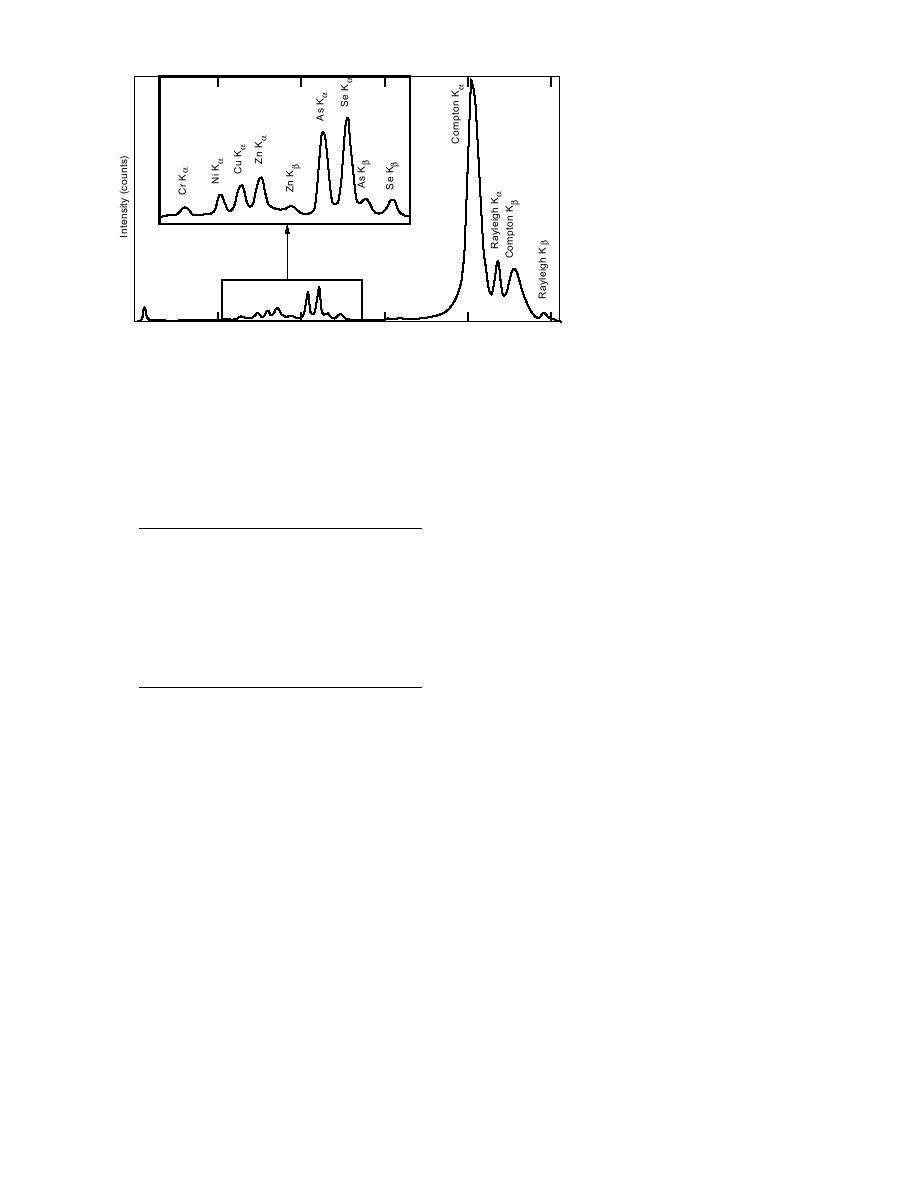
5-gram quantities of air-dried
materials with particle sizes aver-
aging <600 m in diameter. All
samples were placed into 31-mm-
diameter cups and covered with
a 0.2-mil polypropylene X-ray
film window. XRF analyses were
performed for a period of 300 sec-
onds. Field operations using these
two preparation steps, i.e., drying
and sieving, have shown that up
to a hundred samples can be pro-
cessed and analyzed within a
single day (Grupp et al. 1989,
0
50
100
150
200
250
Garby 1991).
Channel (eV)
Fundamental parameter sam-
Figure 1. Spectrum of several characteristic Kα and Kβ peaks for metals
ple analysis was performed using
and Compton and Rayleigh backscatter.
both XRF instruments after the se-
lection of the appropriate soft-
ware application and assessing
Table 2. Daily response factors established for
the instrumental tuning. For the Spectrace 9000 this
Cu, Zn, As, and Pb based on the SRM 2710
involved checking the resolution and the back-
certified reference material.
ground response with supplied reference materi-
Response factor (intensity/concentration)
als and selecting the fine particle application. The
FP software application supplied with the X-Met
Cu
Zn
As
Pb
920 system was based upon the analysis and total
12.0
33.9
1.09
39.5
characterization of the finely ground NIST SRM
11.9
34.8
0.90
38.0
2710.
12.3
34.4
1.04
39.6
The RF/Comp. Kα normalization analysis meth-
Average
12.1
34.4
1.01
39.0
od was only performed with the X-Met 920. To per-
Std. dev.
0.21
0.45
0.098
0.90
form this method of analysis, the energy spectrum
% RSD
1.7
1.3
9.7
2.3
from each analysis was saved and transformed
SRM 2710 concentration (g/g)
from a 2048- to a 256-channel spectrum for close
examination. This approach was used because it
2950
6952
626
5532
was easier to measure the intensity of smoothed
peaks and, once transformed, up to six spectra
Cr/g, to establish an RF. All of the other metals
could be overlaid. Measurements included the in-
analyzed were quantified relative to RFs obtained
tensity of elemental spectral lines and the inten-
for the Rocky Mountain Arsenal (RMA) soil ma-
sity of the incoherent radiation backscatter peak
trix spiked with 1000 g metal/g. Even with a high-
(Comp. Kα). The intensity of the incoherent radia-
resolution XRF instrument, the As Kα and Pb Lα
tion backscatter reflects both the composition of
lines (10.532 and 10.549 keV, respectively) over-
light elements (e.g. carbon, nitrogen, silicon, etc.)
lap, so the As Kβ and Pb Lβ peaks were used. In ad-
in the sample matrix as well as the overall concen-
dition, because high levels (>0.4%) of Fe were pres-
tration of detectable analytes (Nielson and Sand-
ent in many of the laboratory-treated soil matri-
ers 1983). Intensities of both the baseline and peaks
ces, the Fe Kβ peak (7.06 keV) had to be subtracted
of interest were recorded from the computer dis-
from the Co Kα peak (6.92 keV), due to a spectral
play after selecting the appropriate spectrum chan-
overlap. In the case of Co, the Kβ line was not used
nels. Concentration estimates were then manually
because of insufficient response (intensity).
determined by multiplying the baseline-corrected
analyte signal intensity by the normalization fac-
tor, followed by the response factor. The normal-
ANALYSIS
ization factor is the quotient of the Compton Kα
Only intrusive sample-analysis procedures
peak intensity of the certified reference material,
were used in this study. Samples consisted of 2- to
divided by that of the samples. A more complete
3





 Previous Page
Previous Page
